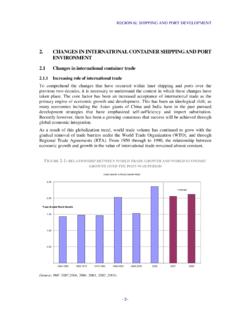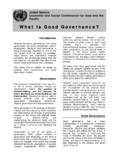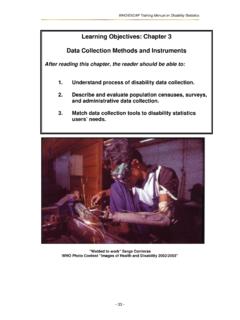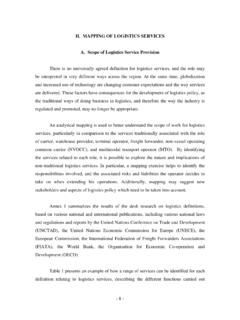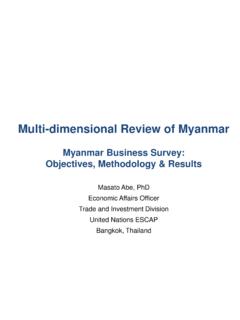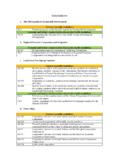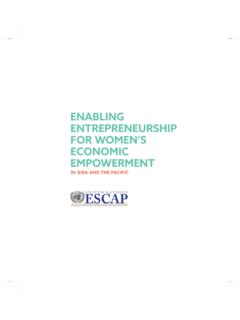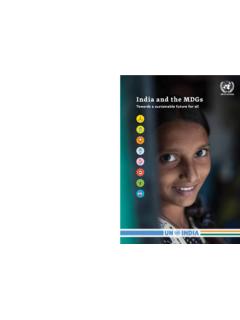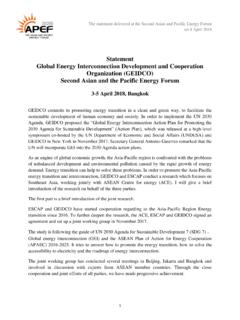Transcription of Monitoring and Evaluation Framework - ESCAP
1 Revision of M&E Framework 17 december 2007 Multi-donor Voluntary Trust Fund on tsunami Early Warning Arrangements in the Indian Ocean and Southeast Asia Monitoring and Evaluation Framework december 2008 UNITED NATIONS ESCAP 1 1. INTRODUCTION PURPOSE The Monitoring and Evaluation (M & E) Framework for the Multi-Donor Voluntary Trust Fund on tsunami Early Warning Arrangements in the Indian Ocean and Southeast Asia (also known as tsunami Regional Trust Fund or simply Trust Fund) provides an overview and operational mechanism of M&E for the Fund as a whole, and for individual projects supported by the Fund.
2 It also explains the different requirements and responsibilities in M&E and how the results from M&E will be used to inform ongoing and future planning and implementation processes in relation to the Fund s operations. BACKGROUND ON THE TRUST FUND The Trust Fund, established in late 2005 in the aftermath of the indian ocean tsunami of 2004 and administered by ESCAP , contributes to the overall United Nations (UN) response to the development of regional tsunami early warning systems (TEWS) and disaster preparedness.
3 The Trust Fund has received contributions of approximately US$ million, through the foundation donor (Government of Thailand), the key donor (Government of Sweden), and other donors (Nepal and Turkey). The Trust Fund contributes to narrowing the capacity gaps in the region and ensures development of an integrated regional early warning system based on adequate resources. The Fund is demand-driven and works on the basis of competitive rounds of funding, in which proposals are received and reviewed by various appraisal bodies, and subsequently decisions made by the Advisory Council.
4 It is essential to undertake Monitoring and Evaluation in order to measure and assess the performance of the Trust Fund overall as well as individually-supported projects under the Fund, to learn from findings and experiences, and to decide on what actions to take to achieve better results. At the Fund level, M&E will be useful to determine what additional and unique previously unmet value the Fund s operations will bring to address specific gaps. It will also assist in the process of prioritizing activities for the Fund to support, as the Fund s resources are limited and represent a fraction of the resources needed to set up the regional TEWS.
5 At the project level, M&E will be a useful mechanism to assist the project implementers to check and determine the progress they are bringing through their project efforts, and for ESCAP and the Council at large to enable them to provide oversight on project progress and challenges in a structured manner. CONTEXT Broader relationship with results-based management (RMB) This M&E Framework is anchored within the broader system of results-based management (RBM), instituted within the UN in its normal operations.
6 RMB is a management approach that focuses fundamentally on desired results. Supporting systems are put in place, and processes and activities are implemented, with a view to achieving such results. RBM aims to enhance the organization s relevance, accountability and transparency. It promotes ownership by staff and other stakeholders and encourages organizational learning. Ultimately, the purpose of RBM in 2 the context of this Framework is to strengthen the efficiency, effectiveness, impact and sustainability of the Fund and individual projects.
7 The progress of each project and the Fund as a whole are measured using a results Framework which specifies the hierarchy of results: impact, outcome, expected accomplishments, and outputs/activities. Links to Monitoring and Evaluation guides at the UN This M&E system builds upon the principles and follows the guidance available in existing M&E frameworks within the United Nations. The UN Office of Internal Oversight Services (OIOS) has produced various guides on M&E on topics such as Evaluation in the UN Secretariat, as well as on programme performance and evaluation1.
8 These documents provide the overall conceptual and methodological Framework for M&E in the UN, including ESCAP . The UN Evaluation Group (UNEG) has also developed standards and norms on evaluation2 which provide a robust normative basis for M&E. As the Trust Fund is administered by ESCAP , this M&E system for the Fund takes full advantage of and synergizes directly with ESCAP s M&E Guide, which responds to the recommendations of its governing bodies, OIOS guidance and UNEG documents. 2. Monitoring and Evaluation OVERVIEW The overall responsibilities for M&E are defined by the organizational structure of the main stakeholders in the Trust Fund as well as that of the ESCAP in its function as administrator of the Fund.
9 Monitoring : the primary responsibility for Monitoring at the project level lies with the implementing organization, with ESCAP providing supplementary review, technical oversight, coordination and quality assurance. At the overall Fund level, ESCAP would be the primary entity to carry out Monitoring . This would consist of primary responsibility by the Technical Cooperation section, with support by the Evaluation Unit at PMD, under the oversight and guidance of PMD Division and section chiefs. The Fund s Advisory Council would also be involved in Monitoring , by providing feedback on the progress achieved at the overall Fund level and at the individual project level, as necessary.
10 Evaluation : the primary responsibility for Evaluation lies with ESCAP . ESCAP manages the evaluations and would call upon external consultants to undertake the evaluations of the Fund, with feedback and guidance from the Advisory Council. At the project level, it would be the responsibility of the implementing organization to find 1 Office of Internal Oversight Services (OIOS) A Guide to Using Evaluation in the United Nations Secretariat , June 2005.
